1912 Ladies Night Jewelry Box
from McKinley Lodge No. 878
A.F. & A.M.
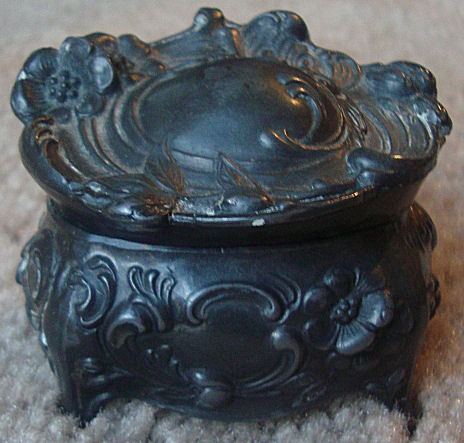
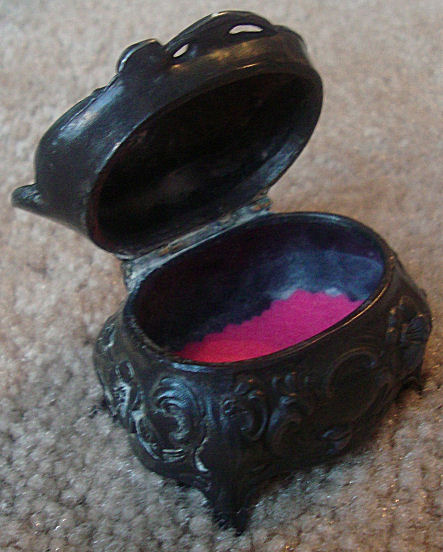
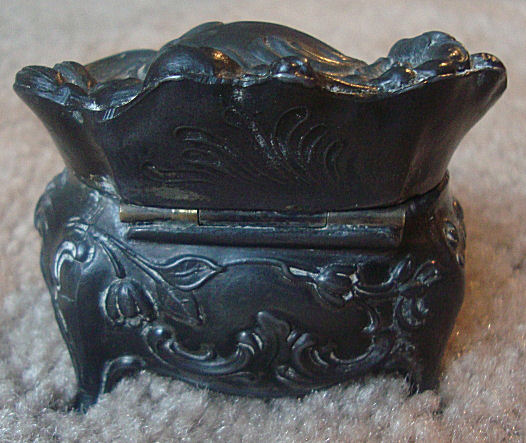
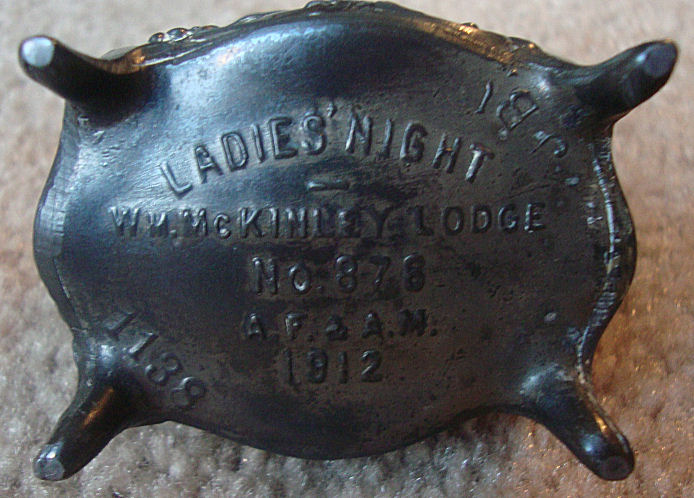
Pictured above is a very small “jewelry box.” Would hold a ring
or two or a broach so I have taken the liberty to call it a “ring box.” 1 ¾”
tall at back and 1 ¼” tall at front (lid slopes forward.) 2 1/8” wide and 1 1.4”
deep. Appears to be made of some sort of metal (pot metal?) Hinge
works perfectly and no damage at all. On bottom is “Ladies Night, W M.
McKinley Lodge, No. 878, A. F. & A.M., 1912.” Also 1138 and a makers mark.
William McKinley, our 25th President,
1897 - 1901, was made a Mason, May 3, 1865, in Hiram Lodge No. 21, A.F. & A.M.,
Winchester, Virginia.

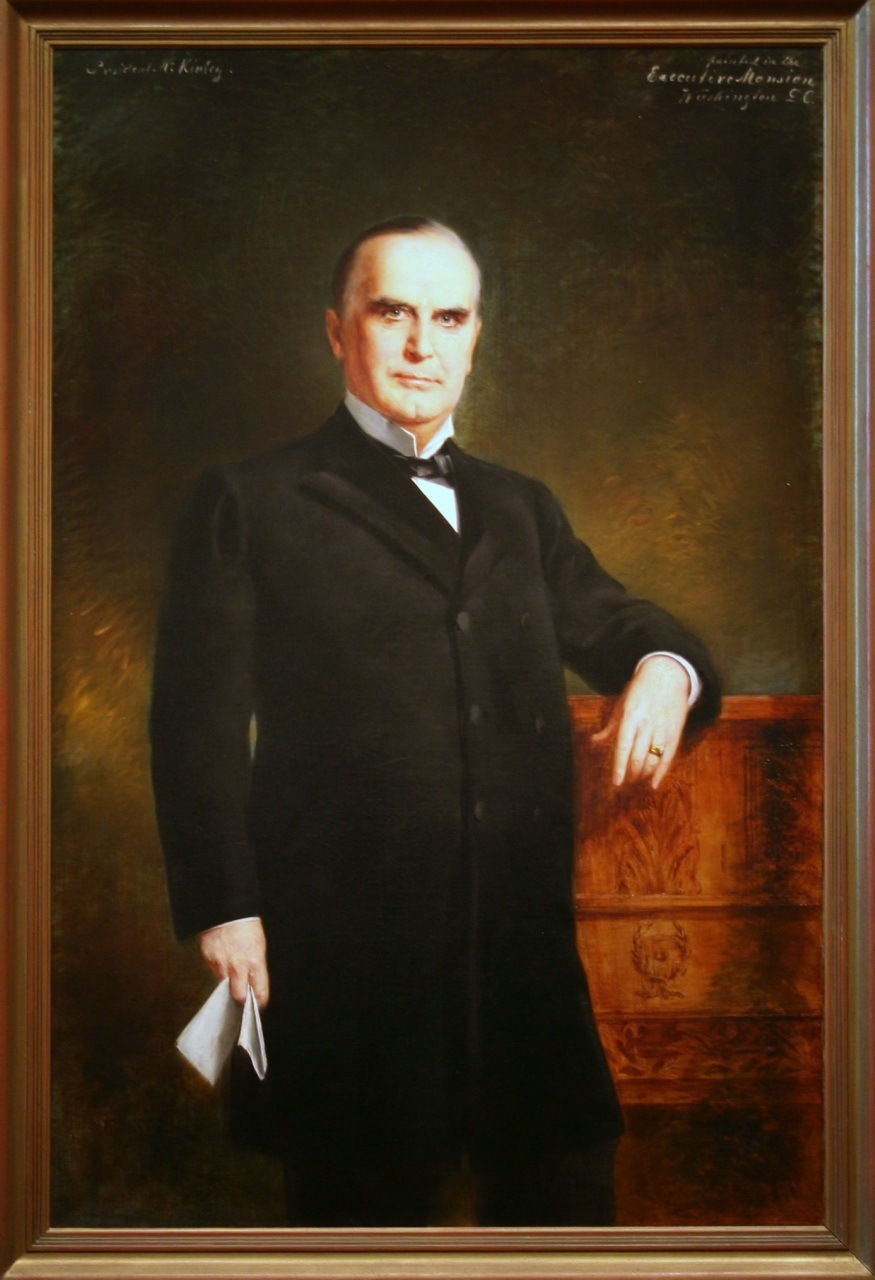
William McKinley ( 1843 - 1901 )
Twenty-fifth President of the United States, 1896-1901. b. Jan. 29, 1843 in
Niles, Ohio. Educated at Poland Academy and Allegheny Coll. He taught in public
schools, and at the outset of the Civil War, enlisted as a private in the 23rd
Ohio Volunteer Infantry, rising through grades to captain in 1864, and brevetted
major by President Lincoln on March 13, 1865, for gallantry in battle. Following
the war he took a course at the Albany (N.Y.) Law School and was admitted to the
Ohio bar in 1867, settling at Canton. He was U.S. congressman from Ohio from
1876-91. An advocate of high protective tariff, he was chairman of the committee
on ways and means that reported the tariff bill of 1890, known as the "McKinley
Bill." When his district was changed by a Democratic legislature, he was
defeated for congress in 1890. He was with the organization directed by Marcus
Hanna, Republican politician of Cleveland. He was elected governor of Ohio for
two successive terms, 1892-96. He was elected president in 1896 by a popular
plurality of 600,000 votes and in 1900 with plurality of 849,000 votes. He was
shot by the anarchist, Leon Czolgosz, on Sept. 6, 1901 at Buffalo, N.Y. and died
Sept. 14. Although a Union Army major, he received his degrees in a southern
lodge during the war. He was protecting and managing the army hospital at
Winchester, Va., and was struck by the ties which he saw existing between the
Union surgeons and Confederate prisoners. When he learned the reason for such a
brotherly spirit in spite of war and hatred, he asked to be admitted to the
Craft. His petition was presented to Hiram Lodge No. 21 of Winchester and he was
initiated May 1, 1865, passed May 2, and raised May 3. J. B. T. Reed, a
Confederate chaplain, served in the East. On Aug. 21, 1867 he affiliated with
Canton Lodge No. 90, Canton, Ohio and on June 2, 1868 became a charter member of
Eagle Lodge No. 431 of Canton—it was later named William McKinley Lodge in his
honor. A member of Canton Chapter No. 84, R.A.M., he received the Mark, Past and
Most Excellent degrees on Dec. 27, 1883 and the Royal Arch on Dec. 28. He
received the commandery orders on Dec. 18, 23, 1884 in Canton
The
Assassination of President McKinley
On September 6, 1901, U.S.
President William McKinley spent the morning visiting Niagara Falls with his
wife before returning to the Pan-American Exposition in Buffalo, New York in
the afternoon to spend a few minutes greeting the public.
By about 3:30 p.m., President
McKinley stood inside the Temple of Music building at the Exposition, ready to
begin shaking the hands of the public as they streamed into the building. Many
had been waiting for hours outside in the heat for their chance to meet the
President. Unbeknownst to the President and the many guards who stood nearby,
among those waiting outside was 28-year-old anarchist Leon Czolgosz who was
planning to kill President McKinley.
At 4 p.m. the doors to the
building were opened and the mass of people waiting outside were forced into a
single line as they entered the Temple of Music building. The line of people
thus came up to the president in an organized fashion, with just enough time to
whisper a "Nice to meet you, Mr. President," shake President McKinley's hand,
and then be forced to continue along the line and out the door again.
President McKinley, the 25th
president of the United States, was a popular president who had just started his
second term in office and the people seemed clearly glad to get a chance to meet
him. However, at 4:07 p.m. Leon Czolgosz had made it into the building and it
was his turn to greet the President.
In Czolgosz's right hand, he held
a .32 caliber Iver-Johnson revolver, which he had covered by wrapping a
handkerchief around the gun and his hand. Although Czolgosz's swaddled hand was
noticed before he reached the President, many thought it looked like it covered
an injury and not that it was hiding a gun. Also, since the day had been hot,
many of the visitors to see the President had been carrying handkerchiefs in
their hands so that they could wipe the sweat off their faces.
When Czolgosz reached the
President, President McKinley reached out to shake his left hand (thinking
Czolgosz's right hand was injured) while Czolgosz brought up his right hand to
President McKinley's chest and then fired two shots.
One of the bullets didn't enter
the president - some say it bounced off of a button or off the president's
sternum and then got tucked into his clothing. The other bullet, however,
entered the president's abdomen, tearing through his stomach, pancreas, and
kidney. Shocked at being shot, President McKinley began to sag as blood stained
his white shirt. He then told those around him, "Be careful how you tell my
wife."
Those in line behind Czolgosz and
guards in the room all jumped on Czolgosz and started to punch him. Seeing that
the mob on Czolgosz might easily and quickly kill him, President McKinley
whispered either, "Don't let them hurt him" or "Go easy on him, boys."
President McKinley was then
whisked away in an electric ambulance to the hospital at the Exposition.
Unfortunately, the hospital was not properly equipped for such a surgery and the
very experienced doctor usually on premises was away doing a surgery in another
town. Although several doctors were found, the most experienced doctor that
could be found was Dr. Matthew Mann, a gynecologist. The surgery began at 5:20
p.m.
During the operation, the doctors
searched for the remains of the bullet that had entered the President's abdomen,
but were unable to locate it. Worried that continued searching would tax the
President's body too much, the doctors decided to discontinue looking for it and
to sew up what they could. The surgery was completed a little before 7 p.m.
For several days, President
McKinley seemed to be getting better. After the shock of the shooting, the
nation was excited to hear some good news. However, what the doctors did not
realize was that without drainage, an infection had built up inside the
President. By September 13 it was obvious the President was dying. At 2:15 a.m.
on September 14, 1901, President William McKinley died of gangrene. That
afternoon, Vice President Theodore Roosevelt was sworn in as President of the
United States.
After being pummeled right after
the shooting, Leon Czolgosz had been arrested and taken to police headquarters
before nearly being lynched by the angry crowds that surrounded the Temple of
Music. Czolgosz readily admitted that he was the one who had shot the President.
In his written confession, Czolgosz stated, "I killed President McKinley because
I done my duty. I didn't believe one man should have so much service and another
man should have none."
Czolgosz was brought to trial on
September 23, 1901. He was quickly found guilty and sentenced to death. On
October 29, 1901, Leon Czolgosz was electrocuted.
A special "Thank
You" to Brother Fred Lowstetter for sharing pictures of this little jewelry box!

